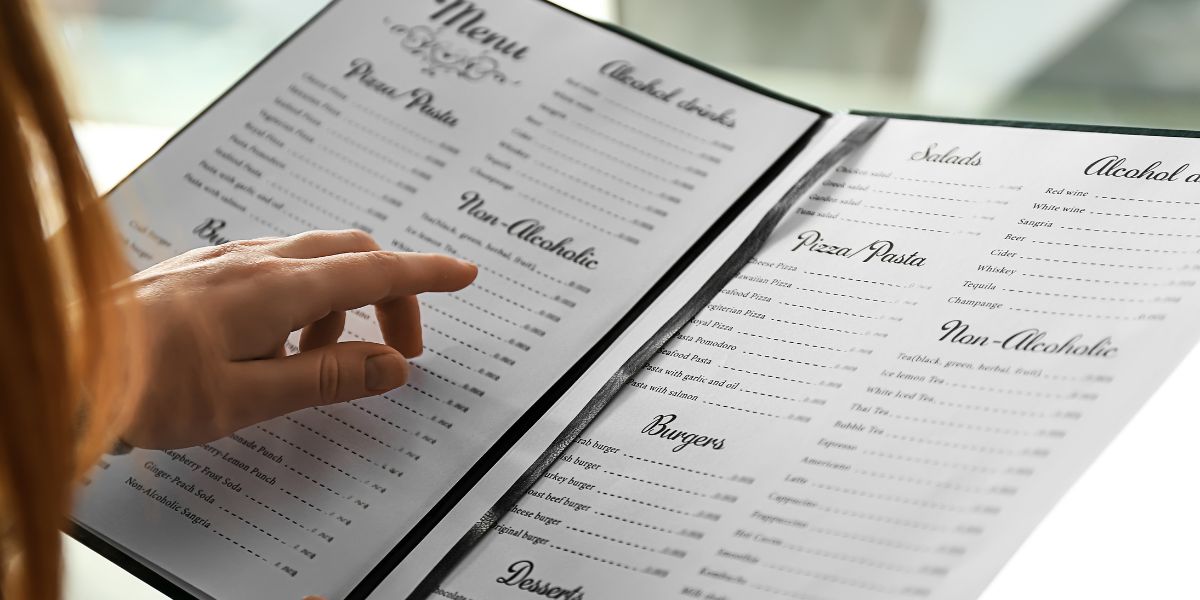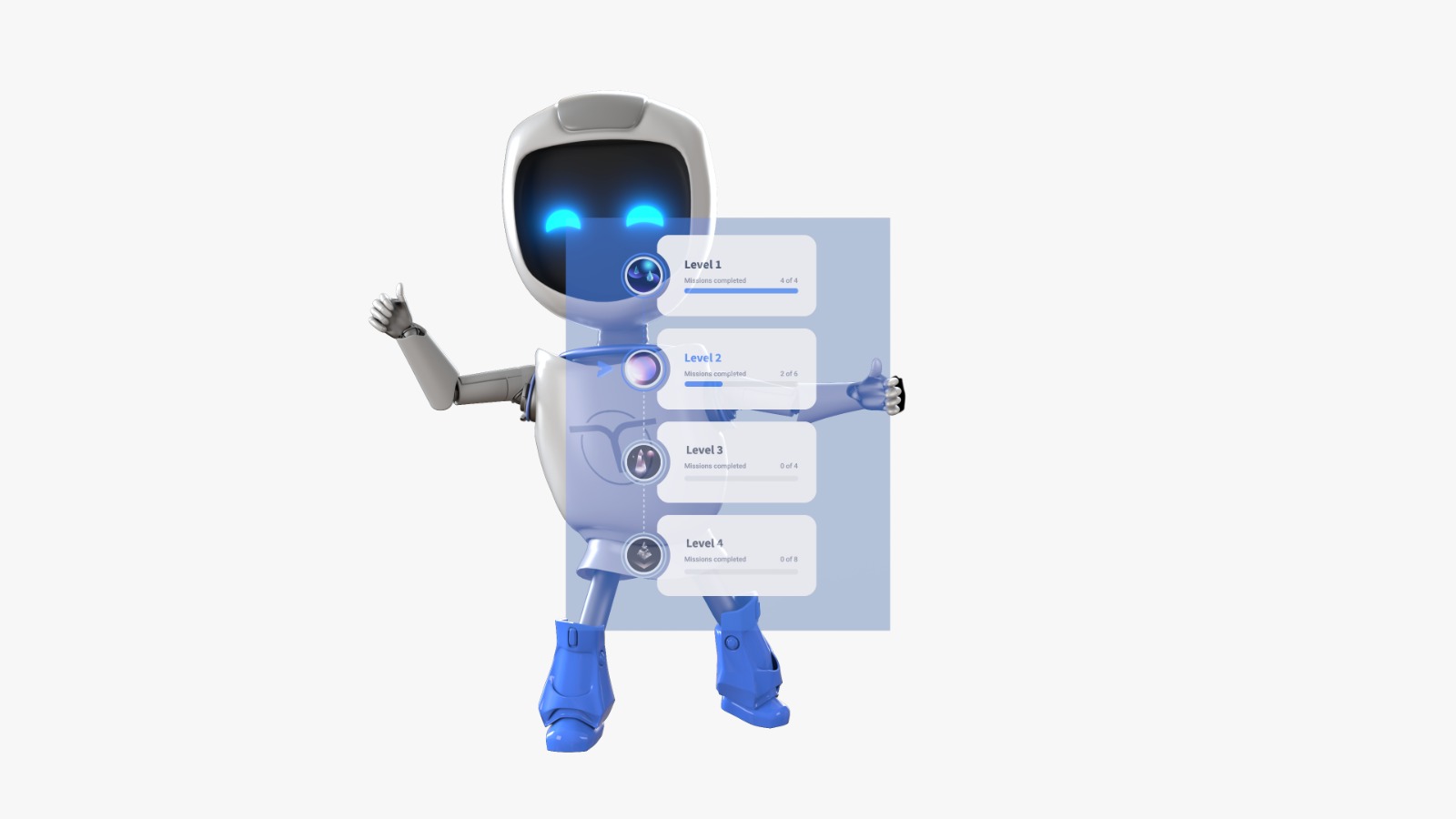In a previous article, we covered 10 essential training topics for restaurant staff, but one key area—menu knowledge training—deserves a deeper look.
A recent study shows that both personal and functional employee behaviors impact customer satisfaction, with personal traits like friendliness having the greatest effect. This highlights why training programs should focus not only on upskilling in soft skills but also on technical knowledge, including menu detail, to improve the dining experience.
So, how do you provide effective menu knowledge training? Simply handing staff a menu to memorize isn’t enough when so many factors come into play.
- Are there allergens in the dishes?
- Which items pair well together?
- What should be recommended if a dish runs out?
- What happens when menus change (due to seasons, trends, or ingredient availability)?
These are some of the questions to consider when providing menu knowledge training to employees, beyond learning the dishes by heart. Knowing the menu is a start, but true understanding comes from combining theory with hands-on experience.
The Benefits of Menu Knowledge Training
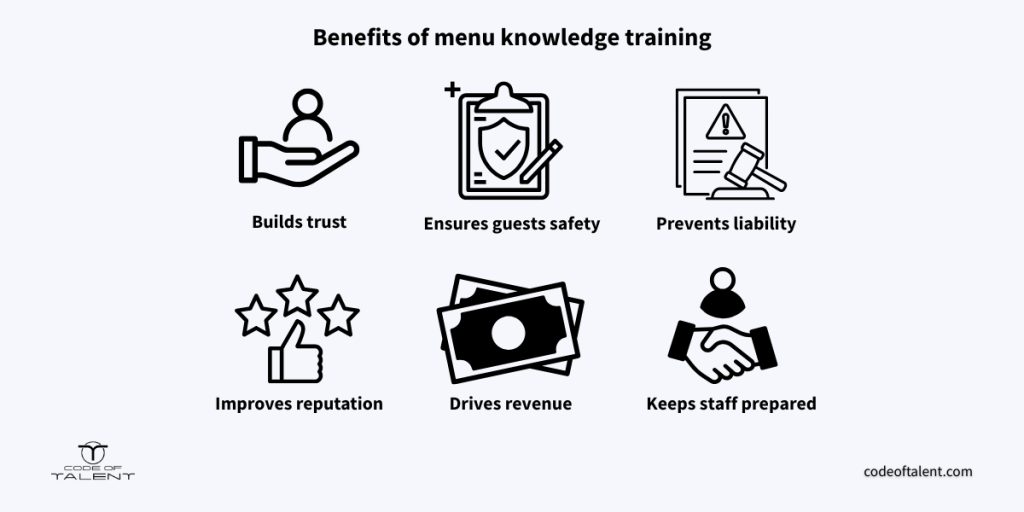
Investing in proper menu knowledge training strengthens every part of the customer service experience and your business. Here’s how:
- Builds trust: Guests feel cared for when staff are informed.
- Ensures safety: Reduces the risk of allergen or dietary mistakes.
- Prevents liability: Helps avoid complaints or legal issues.
- Improves reputation: Accurate information builds a reliable brand image.
- Drives revenue: Confident suggestions increase upsells.
- Keeps staff ready: Trained teams adapt quickly to changes or special requests.
Key Components of Effective Menu Knowledge Training
The benefits outlined above don’t happen by accident. They come from thoughtful, well-structured training. Below are the key components of effective menu knowledge training every hospitality team should focus on.
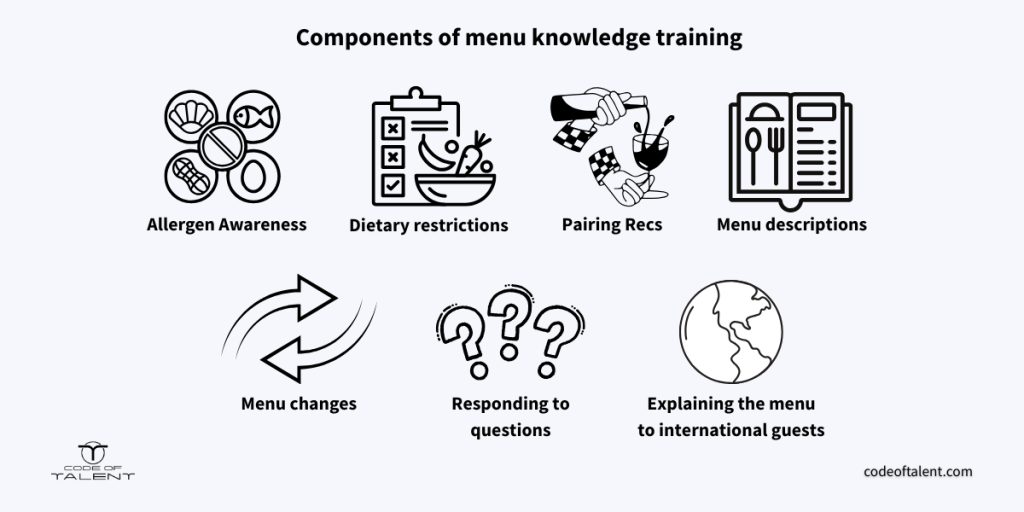
1. Ingredients and Allergen Awareness
Why it’s important: According to a study on allergens in the dining industry, restaurant meals often lack the consistent and clear allergen labeling found on packaged foods. This increases the risk of allergic reactions, from mild discomfort to life-threatening emergencies, and why it’s essential for staff to:
- Understand which dishes contain common allergens (e.g., nuts, dairy, shellfish, gluten).
- Know potential cross-contamination risks.
- Communicate clearly with guests who have dietary restrictions.
How to train effectively:
- Quiz: Test staff on allergen content for specific dishes on the menu using multiple-choice questions.
- Scenerio: Role play guest interactions where employees should explain allergen risks and suggest alternatives.
- Learning: Provide short learning modules that break down common allergens, where they appear, and best practices for communication.
2. Dietary Options
Why it’s important: Beyond allergies, many guests follow personal, religious, or medical diets: vegan, vegetarian, keto, halal, Low-FODMAP (for IBS), and gluten-free, to name a few. Misunderstanding these needs can lead to dissatisfaction or loss of customers. Staff should:
- Know which dishes are compliant with various dietary needs.
- Understand how ingredients or preparation methods may disqualify a dish.
- Be ready to suggest substitutions or alternatives.
- Maintain a respectful and empathic attitude toward guests’ dietary choices. While this may seem like common sense, some staff still meet dietary restrictions with skepticism or even condescension.
How to train effectively:
- Survey: Let staff identify which dishes meet specific dietary categories.
- Scenario: Ask them to explain how they’d assist a guest who requests a vegan but protein-rich dish.
- Idea: Encourage them to brainstorm ingredient swaps to make existing dishes more inclusive.
3. Pairing Recommendations
Why it’s important: Great pairing suggestions not only elevate the guest experience but also increase sales. Guests often appreciate expert guidance and may return for that thoughtful touch.
A knowledgeable server can upsell:
- Wine, beer, or cocktail pairings for mains.
- Sides that go well with the main course and make the meal more enjoyable
- Dessert suggestions that balance or finish the meal perfectly.
How to train effectively:
- Quiz: Create a matching game where staff pair dishes with drinks or sides.
- Story: Ask employees to share a time (real or imagined) when a pairing delighted a guest.
- Question: Pose prompts like “What drink would you suggest with our spicy grilled chicken, and why?”
4. Menu Storytelling and Descriptions
Why it’s important: Staff who can describe dishes in vivid detail help guests make informed choices and feel more excited about the meal. This level of comfort and enthusiasm comes from strong menu knowledge training, and it shows guests that the team cares about the food and their overall experience.
Storytelling also adds personality to the experience and brings the brand’s voice to life.
Staff should learn how to:
- Highlight key ingredients and flavors.
- Use descriptive language that reflects the brand (e.g., rustic, refined, adventurous).
- Share background stories or chef inspirations behind dishes when appropriate.
How to train effectively:
- Reflection: Invite staff to describe their favorite dish using brand-aligned language and sensory cues.
- Story: Have them create a fictional or real backstory for a signature dish to make it memorable.
- Learning: Share examples of strong vs. weak descriptions and explain the tone of voice to use.
5. Handling Menu Changes
Why it’s important: Menus often change due to seasonality, product shortages, or chef updates. Some restaurants even change their menus daily, which, while exciting for guests, can be a real challenge for staff, from the back of house to the front. Staff who aren’t informed may give outdated information, which frustrates guests. They must be ready to:
- Learn and remember changes quickly.
- Communicate adjustments to guests with confidence.
- Offer suitable replacements when items are unavailable.
How to train effectively:
- Event: Host short virtual briefings whenever updates are made to the menu.
- Scenario: Ask staff to role play a scenario where they explain a change and offer an alternative.
- Assessment: Combine a short presentation of the changes, followed by a quick quiz to reinforce information.
6. Responding to Guest Questions and Special Requests
Why it’s important: Guests often rely on staff for guidance, especially when trying something new or when they’re unsure. With solid menu knowledge training, team members can confidently answer questions like “What do you recommend?”
Staff should be trained to:
- Think on their feet and respond to last-minute changes or unusual requests.
- Offer thoughtful, personalized recommendations.
- Stay calm and helpful even when they don’t have all the answers.
How to train effectively:
- Question: Use open-ended prompts like “How would you respond if a guest wants something light but filling?”
- Survey: Give staff a set of guest questions and ask them to choose the best response for each.
- Idea: Let them brainstorm creative solutions for common challenges (e.g., out-of-stock dishes, custom dietary needs).
7. Explaining Menus to International Guests
As tourism grows and restaurants welcome more international diners, staff must be prepared to communicate menu details clearly and respectfully across language and cultural barriers. This shows genuine hospitality and strengthens your reputation.
Staff should be trained to:
- Use simple, clear language without culinary jargon.
- Be patient and culturally sensitive to dietary preferences or restrictions.
- Explain dishes using visual aids or translated resources.
- Adapt quickly to guests’ unique questions or language barriers.
How to train effectively:
- Question: Ask, “How would you describe this dish to a guest who doesn’t speak English well?”
- Role-play: Practice common scenarios where staff explain popular menu items or suggest alternatives.
- Learning: Teach cultural awareness, such as which ingredients or beverages to avoid for certain guests.
How to Deliver Menu Knowledge Training That Really Works with Code of Talent
Training your team to know the menu inside and out is key to great guest service, but it can be tricky to keep staff engaged and make sure they remember everything. However, using a platform like Code of Talent can make this process much easier.
Why Choose Code of Talent?
Code of Talent is a simple, smart microlearning platform designed to create training that’s easy, fun, and effective. Microlearning means breaking training into small, focused lessons that are quick to complete and easier to remember, which works especially well for customer-facing teams.
It combines engaging content (see the photo below) with gamification, a way to make learning fun and competitive. As learners complete each mission, they progress along a journey map and climb leaderboards, which motivates them to keep improving.
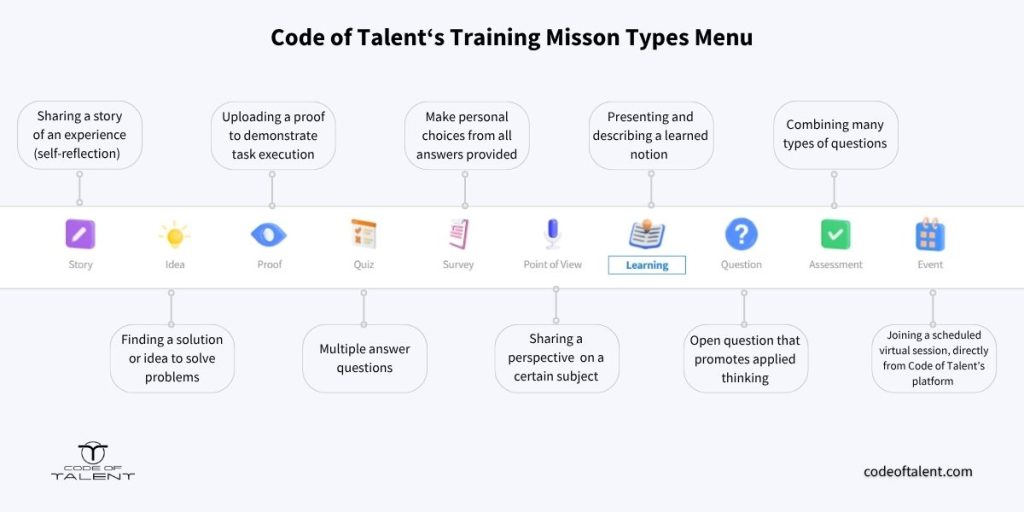
Code of Talent also features built-in AI that helps tailor the training to your specific needs, making the whole process more effective for your staff.
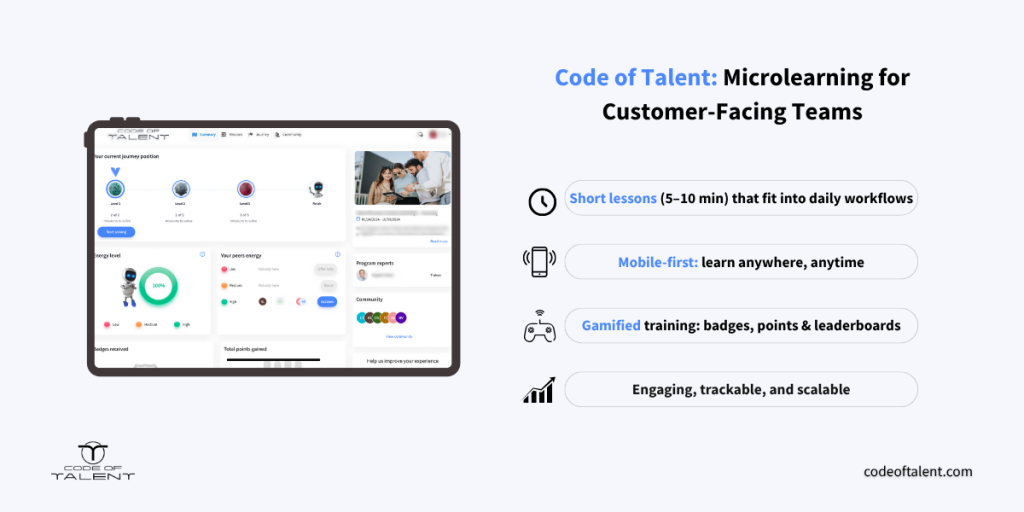
Training Information Right from Your Menu
To create a menu knowledge training, Code of Talent makes it easy: just share your website or digital menu. Its AI will pull out the important details to build training “missions” focused on your dishes, from ingredients and allergens to drink pairings and specials.
Make it Your Own
Once AI generates the training missions, you’re in control. You can tweak and customize the training missions to match your restaurant’s style and the way you want your team to serve guests. Change the mission type, rephrase questions, or customize answers—everything is allowed.
Deploy It Instantly
Once your menu knowledge training is ready, Code of Talent gives you flexible ways to share it with your team. You can:
- Generate QR codes for staff to scan.
- Share direct links through email, chat apps, or your internal system.
- Upload an Excel file with employee information to enroll multiple team members at once.
- Send invitations directly through the platform.
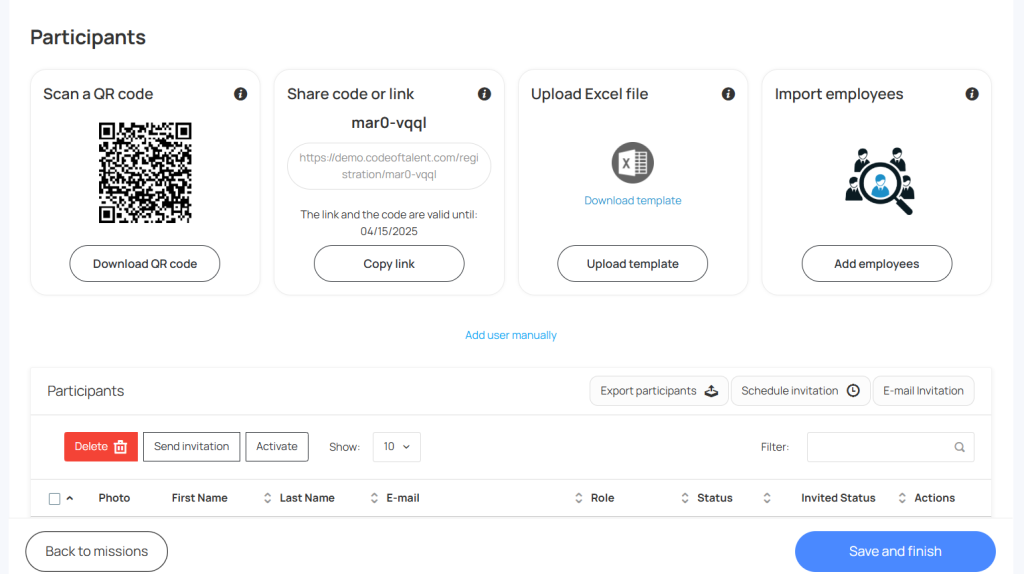
AI Assistant for Consistent, Expert Feedback
As a restaurant manager, you likely don’t have time to review every detail of your team’s training progress. That’s why Code of Talent includes a built-in AI assistant that automatically evaluates employee responses and offers suggestions for improvement. This feature works like a built-in expert, giving topic-specific feedback that keeps staff engaged and learning effectively.
This way you can focus on what really matters: analyzing results and making improvements.
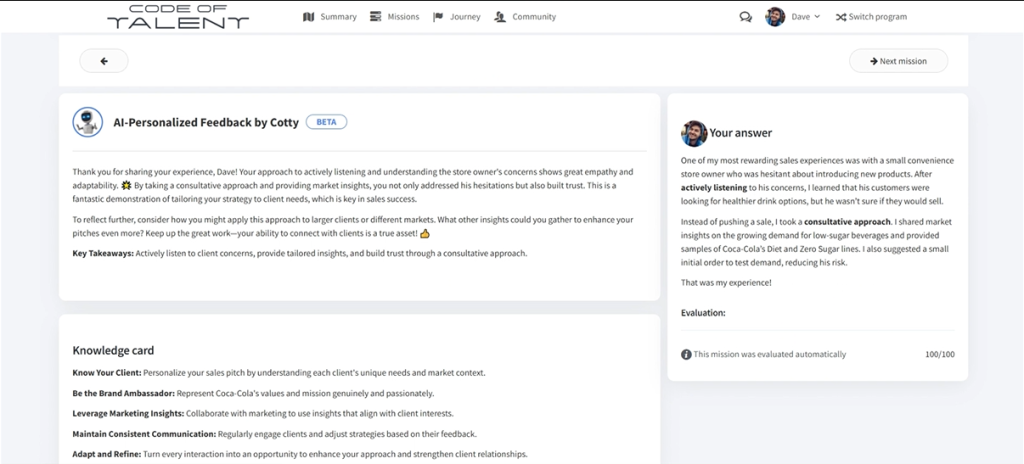
Analytics and Data-Driven Insights
Understanding how well your menu knowledge training is working is just as important as delivering it. Code of Talent gives you access to real-time analytics that show exactly how your staff are progressing.
Track key metrics like:
- Completion rates
- Mission points
- Time spent on each mission
- Areas where staff may be struggling
With these insights, you can quickly spot knowledge gaps, identify high performers, and adjust your training program where needed.
Whether you’re onboarding new team members or refreshing knowledge across locations, data helps you make smarter decisions faster.
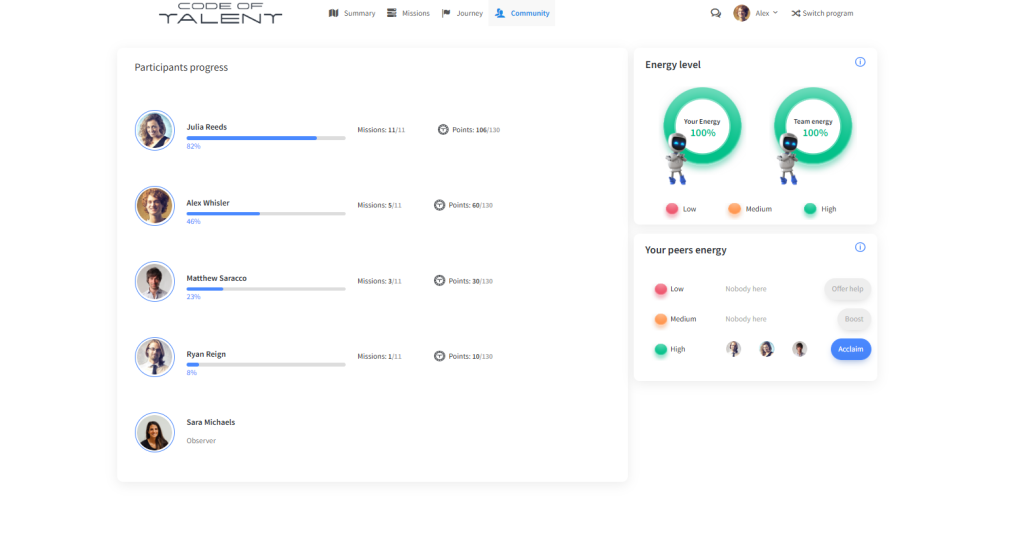
Final Thoughts
Great service starts with confident, informed staff. With the right menu knowledge training, your team can deliver better guest experiences, improve sales, and handle any question with ease.
Code of Talent makes it easy to train staff in a way that’s engaging, efficient, and tailored to the realities of the hospitality industry. Ready to see the difference for yourself?
Start your free trial today and explore how Code of Talent can transform your team’s training experience and download our free Menu Knowledge Training Checklist to make sure you’re covering all the essentials!
Cover photo: Freepik

